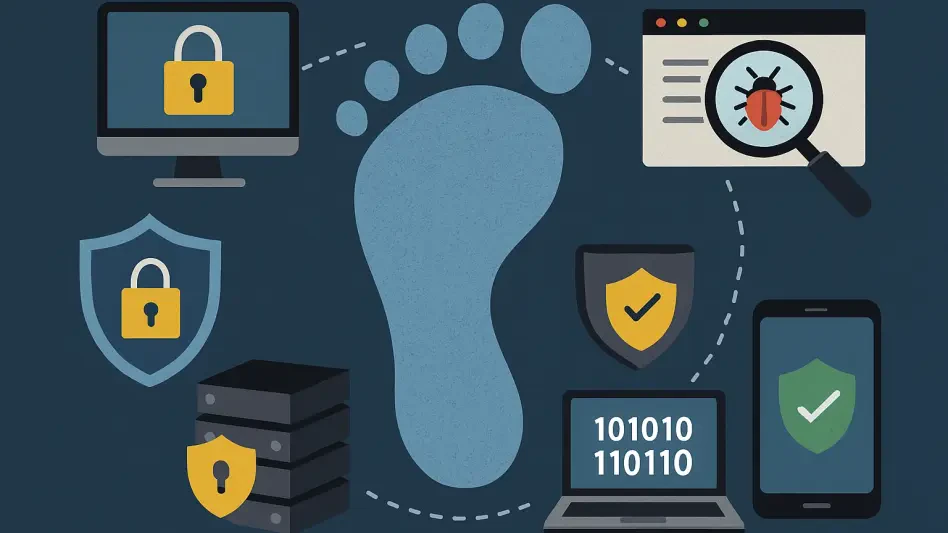In the dynamic and ever-shifting digital landscape of today, protecting an organization’s online presence has emerged as a critical imperative for businesses across all sectors, as cyber threats like data breaches, phishing schemes, and brand impersonation escalate at an alarming rate. These dangers pose significant risks to companies, from small startups to sprawling global enterprises. A digital footprint, encompassing every trace left across the surface web, deep web, and dark web, can become a treasure trove for cybercriminals if not adequately safeguarded. The consequences of neglecting this aspect of cybersecurity can be devastating, leading to financial losses, reputational damage, and legal ramifications. As technology continues to advance, so do the tactics of malicious actors, making it essential for organizations to stay ahead of potential vulnerabilities. Digital footprint monitoring tools have become indispensable in this fight, offering the ability to track online exposure, detect threats in real time, and respond swiftly to mitigate risks. This article explores ten leading tools in this space, providing a comprehensive overview of their features, strengths, and ideal applications. By delving into these solutions, the aim is to equip businesses with the knowledge needed to fortify their cybersecurity defenses. Whether the focus is on brand protection, supply chain security, or operational integration, these platforms offer a spectrum of capabilities to address the diverse challenges of the digital realm. Let’s navigate this complex terrain to understand how these cutting-edge tools can help organizations maintain trust and security in an increasingly interconnected world.
The Rising Importance of Digital Footprint Monitoring
In the current digital age, the significance of monitoring an organization’s online presence cannot be overstated, as every interaction—be it a social media update, a website transaction, or a vendor collaboration—leaves a trace that can be exploited by cybercriminals. The sophistication of attacks has reached unprecedented levels, with hackers employing advanced techniques to steal sensitive data, impersonate trusted brands, and disrupt critical operations. A single security lapse can cascade into substantial financial losses, erode customer confidence, and trigger regulatory penalties. This reality underscores the urgency for businesses to adopt proactive measures that provide visibility into their digital vulnerabilities. Digital footprint monitoring tools serve as a vital line of defense, enabling organizations to identify risks before they escalate into full-blown crises. These platforms scan vast swaths of the internet, including hidden corners like underground forums, to uncover potential threats such as leaked credentials or malicious domains. By offering real-time insights, they empower companies to act decisively, preventing minor issues from becoming major incidents. Beyond mere detection, these tools often provide actionable intelligence, helping security teams prioritize and address the most pressing dangers. As cyber threats continue to evolve, integrating such monitoring into a broader cybersecurity strategy is no longer a luxury but a fundamental requirement for maintaining operational integrity and safeguarding stakeholder trust.
The growing interconnectivity of business ecosystems further amplifies the need for robust digital footprint monitoring, especially as organizations increasingly rely on third-party vendors and cloud-based services. A breach in a partner’s system can easily ripple through an entire supply chain, exposing sensitive information and disrupting workflows. This interconnected risk landscape means that companies must extend their security oversight beyond internal networks to include external touchpoints. Monitoring tools address this challenge by assessing the cyber health of vendors and partners, identifying weak links that could compromise overall security. Additionally, the rise of remote work and digital-first operations has expanded the attack surface, creating more entry points for malicious actors to exploit. With employees accessing systems from various locations and devices, the potential for data exposure has surged, making comprehensive monitoring essential. These tools not only track external threats but also help ensure compliance with stringent data protection regulations, which have become more prevalent globally. By aligning cybersecurity practices with legal requirements, organizations can avoid costly fines and reputational harm. The imperative to monitor digital footprints is thus rooted in both defensive necessity and strategic foresight, ensuring that businesses remain resilient amid a constantly shifting threat environment.
Essential Features for Effective Digital Footprint Tools
When evaluating digital footprint monitoring tools, certain core functionalities stand out as critical for ensuring robust protection against the multifaceted cyber threats facing organizations today. Real-time alerting tops the list as an indispensable feature, enabling businesses to receive immediate notifications when potential risks, such as phishing domains or leaked credentials, are detected. This capability allows security teams to respond swiftly, often before significant damage occurs, thereby reducing the window of opportunity for attackers. Without real-time insights, organizations risk delayed reactions that could exacerbate the impact of a breach or fraud attempt. Moreover, the ability to customize alert thresholds ensures that notifications are relevant and actionable, preventing alert fatigue among staff. This feature is particularly valuable in high-stakes environments where every second counts, such as financial institutions or e-commerce platforms handling sensitive customer data. Tools equipped with this functionality provide a proactive edge, transforming raw data into timely interventions that can safeguard both assets and reputation. As cyber threats become more dynamic, the emphasis on instantaneous detection and response continues to shape the design of leading monitoring solutions, making real-time alerts a non-negotiable component of any effective cybersecurity toolkit.
Another pivotal feature to consider is the integration of artificial intelligence (AI) and machine learning, which significantly enhances a tool’s ability to process and analyze vast quantities of data across diverse online platforms. These technologies empower monitoring solutions to identify subtle patterns indicative of malicious activity, such as unusual user behavior or emerging threat signatures, with a precision that manual methods cannot match. By reducing the incidence of false positives, AI-driven tools ensure that security teams focus on genuine risks rather than sifting through irrelevant noise. This predictive capacity also allows for anticipatory measures, enabling organizations to fortify defenses against threats before they fully materialize. For instance, machine learning algorithms can adapt to evolving attack vectors, learning from past incidents to better anticipate future risks. Such advancements are crucial in an era where cybercriminals continually refine their tactics to bypass traditional security measures. Additionally, AI can streamline reporting by contextualizing threats, providing deeper insights into their origins and potential impact. As businesses grapple with increasingly complex digital environments, tools leveraging these intelligent technologies offer a strategic advantage, ensuring not just reactive protection but a forward-looking approach to cybersecurity that aligns with long-term resilience goals.
Leading Solutions for Comprehensive Threat Detection
Among the standout tools for detecting a wide array of digital threats, Kaspersky Digital Footprint Intelligence emerges as a formidable option, particularly for large enterprises with significant brand protection needs. This platform excels in monitoring across all layers of the web, including the often-overlooked dark web, where stolen data and criminal activities frequently surface. Its predictive intelligence capabilities allow organizations to anticipate threats through advanced analytics, while its threat attribution feature links digital risks to specific adversaries, providing unparalleled depth in understanding attack origins. Kaspersky’s global threat intelligence feeds further enhance detection accuracy, ensuring comprehensive visibility into risks like domain spoofing and targeted phishing campaigns. Though its higher cost and complex setup may pose challenges for smaller entities, the tool’s robust reporting and actionable insights justify the investment for organizations facing high-stakes cyber risks. Industries such as finance or technology, where brand reputation is paramount, will find Kaspersky’s depth of coverage particularly valuable. Its ability to deliver not just alerts but strategic guidance sets a benchmark for what comprehensive threat detection should entail, making it a top-tier choice for businesses prioritizing proactive defense over mere reaction.
ZeroFox offers another powerful solution, with a specialized focus on brand impersonation and social media-based threats, catering to businesses with substantial online exposure. Its strength lies in the rapid identification of fraudulent activities across platforms like social networks, mobile applications, and deep web forums, often detecting issues before they escalate into significant financial or reputational losses. ZeroFox employs AI-driven analytics to ensure real-time fraud detection, covering billions of digital assets globally, which makes it an ideal fit for regulated industries such as healthcare or retail. The platform’s user-friendly interface facilitates adoption, though its pricing might deter budget-constrained organizations. For companies where speed is critical—such as those managing high-profile public-facing brands—ZeroFox provides a distinct advantage with its swift threat identification and response mechanisms. Its coverage of diverse attack surfaces ensures that no corner of a company’s digital presence is left unprotected, addressing risks that are often missed by narrower tools. This makes ZeroFox a compelling option for enterprises seeking to safeguard their online identity against the pervasive threat of impersonation and related cybercrimes.
Group-IB rounds out this category with its unique blend of digital risk protection and cybercrime investigation expertise, making it especially relevant for sectors like banking and retail that face heightened fraud risks. The platform distinguishes itself by connecting digital exposures to real-world adversaries, offering investigative context that goes beyond standard alerts. Its coverage of sophisticated attacks, including ransomware and executive impersonation, is bolstered by deep visibility into both surface and dark web environments. Features like anti-fraud intelligence and counterfeit monitoring add layers of protection against complex schemes that target customer trust. While its cost and setup complexity may not suit smaller businesses, Group-IB’s ability to provide threat attribution and contextualized reporting is invaluable for organizations needing to understand the ‘who’ and ‘why’ behind attacks. This tool’s focus on linking digital threats to tangible actors enhances strategic planning, enabling security teams to tailor defenses against specific threat profiles. For industries prone to targeted cybercrime, Group-IB offers a depth of insight that transforms raw data into a powerful weapon against digital adversaries.
Specialized Tools for Vendor and Supply Chain Security
For organizations prioritizing supply chain and third-party risk management, Bitsight stands out with its innovative security rating system that evaluates cyber health through numerical benchmarks comparable across industries. This approach simplifies the communication of complex risks to executives and stakeholders, making it easier to align security initiatives with business objectives. Bitsight excels in assessing the cybersecurity posture of vendors and partners, drawing on data from botnets, malware samples, and network traffic to provide a clear picture of external vulnerabilities. Its intuitive dashboards focus on strategic insights rather than granular tactics, which suits companies managing extensive supplier networks. While it lacks deep dark web monitoring, its strength in vendor risk visibility compensates by offering continuous updates and automated rating adjustments. This tool is particularly beneficial for industries with intricate supply chains, such as manufacturing or logistics, where a single weak link can jeopardize overall security. Bitsight’s ability to translate technical data into accessible metrics fosters cross-departmental collaboration, ensuring that cybersecurity remains a priority at every level of the organization. Its emphasis on external risk assessment makes it a cornerstone for businesses aiming to secure their extended ecosystems.
SecurityScorecard complements Bitsight by also focusing on vendor ecosystem risks, utilizing an A-F scoring model to distill cyber health into easily digestible formats for both technical and non-technical audiences. The platform monitors critical areas like domain security, endpoint vulnerabilities, and IP-based risks, providing dynamically updated ratings that reflect real-time changes in threat landscapes. Its sector-based benchmarking allows organizations to measure their performance against peers, offering a competitive edge in risk management. While dark web coverage is limited, SecurityScorecard’s transparency in scoring methodology and compliance reporting tools make it a strong contender for companies with complex vendor relationships. Integration with existing security systems enhances its utility in enterprise settings, facilitating seamless adoption across teams. This tool is ideal for businesses that need to communicate risks clearly to board members or regulatory bodies, ensuring that cybersecurity efforts are understood and supported at the highest levels. Its focus on simplifying intricate data into actionable insights positions SecurityScorecard as a valuable asset for organizations navigating the challenges of third-party security in interconnected business environments.
RiskRecon provides a more cost-effective alternative for monitoring third-party risks, balancing affordability with essential functionality through automated scanning of open systems, configuration flaws, and data exposures. Its cloud-native design ensures scalability, making it suitable for organizations with large vendor bases that need consistent oversight without excessive complexity. RiskRecon’s strength lies in presenting risks in detailed yet accessible formats, appealing to both security professionals and managerial staff who may lack deep technical expertise. The platform offers prioritized remediation guidance, helping teams focus on the most critical issues without being overwhelmed by data. Although it does not delve deeply into dark web threats, its emphasis on supply chain analysis addresses a pressing need for many businesses seeking straightforward risk management solutions. Industries with moderate budgets, such as mid-sized retailers or service providers, will find RiskRecon’s simplicity and actionable insights particularly appealing. By focusing on usability and vendor security, this tool enables organizations to maintain robust defenses without the burden of intricate setups or high costs, ensuring that supply chain vulnerabilities are identified and mitigated effectively.
UpGuard rounds out this category with a user-friendly platform tailored for startups and mid-sized enterprises, emphasizing digital risk management through intuitive dashboards and compliance-focused reporting. Its focus on third-party and vendor security visibility ensures that organizations can monitor external risks without requiring extensive technical resources. UpGuard’s affordability makes it accessible to growing firms, while its solid detection of breach exposures delivers a strong return on investment. Although it lacks advanced dark web monitoring or deep customization options, the tool’s visual simplicity aids in communicating risks across departments, fostering a shared understanding of security priorities. This platform is particularly suited for businesses that prioritize straightforward insights over complex threat hunting, offering a practical approach to managing supply chain risks. UpGuard’s balance of functionality and ease of use supports organizations in building a resilient cybersecurity posture without overextending budgets or staff capabilities. For companies taking their first steps into comprehensive digital footprint monitoring, this tool provides a solid foundation to address vendor-related vulnerabilities while maintaining operational efficiency.
Bridging Detection with Operational Support
BlueVoyant distinguishes itself by integrating digital footprint monitoring with managed security services, addressing a critical gap for organizations that may lack dedicated in-house expertise to act on detected threats. This holistic approach combines AI-driven detection with operational support, ensuring that identified risks are not only flagged but also mitigated through expert intervention. BlueVoyant offers deep insights into external assets, exposed credentials, and impersonation threats, drawing on rich intelligence feeds from global coverage to enhance its effectiveness. Its background in government and defense sectors adds a layer of reliability, making it a trusted choice for large enterprises with complex security needs. While its higher cost may be a barrier for smaller firms, the customizable dashboards and integration-friendly design cater to businesses seeking both visibility and actionable response capabilities. Industries such as technology or critical infrastructure, where downtime or breaches can have catastrophic consequences, will find BlueVoyant’s comprehensive service model particularly beneficial. By bridging the divide between monitoring and mitigation, this tool ensures that organizations can maintain security without the burden of building extensive internal teams, offering a strategic solution for sustained digital protection.
ReliaQuest focuses on unifying external monitoring with internal security workflows, providing a versatile platform that integrates seamlessly with systems like Security Information and Event Management (SIEM), Security Orchestration, Automation, and Response (SOAR), and Endpoint Detection and Response (EDR). Positioned as an open extended detection and response (XDR) solution, it enhances Security Operations Center (SOC) efficiency by reducing false positives through AI-powered analytics. ReliaQuest’s collaborative dashboards and tailored reporting cater to diverse stakeholders, ensuring that insights are accessible across technical and business units. While its coverage of underground threats is less extensive than some niche competitors, its strength in vendor risk monitoring and continuous improvement through intelligent algorithms makes it a compelling choice for mid-to-large organizations. This tool is ideal for businesses aiming to streamline operations by avoiding tool sprawl, consolidating multiple security functions into a cohesive platform. By focusing on integration and operational alignment, ReliaQuest helps organizations optimize their existing resources, ensuring that digital footprint monitoring enhances rather than complicates broader cybersecurity efforts. Its adaptability supports long-term scalability, aligning with the evolving needs of growing enterprises.
Leveraging Ecosystem Strengths for Digital Protection
Google Digital Risk Protection capitalizes on unparalleled data resources and cutting-edge machine learning algorithms to deliver high-accuracy detection of threats like phishing sites, fake advertisements, and brand impersonation attempts. Its seamless integration with Google Cloud tools simplifies adoption for organizations already embedded in that ecosystem, offering a natural fit for businesses leveraging other Google services. The platform’s ability to scale globally ensures that enterprises with significant internet exposure can monitor risks across surface, deep, and dark web environments effectively. Automated takedown services add practical value, enabling swift neutralization of identified threats without manual intervention. While its customization options may be more limited compared to specialized platforms, the sheer breadth of data-driven insights provides a robust foundation for digital risk management. This tool is particularly suited for global brands or tech-driven companies that prioritize scalability and integration over niche tailoring. By harnessing the vast infrastructure of Google, it offers a unique advantage in terms of reach and reliability, ensuring that organizations can protect their digital assets with confidence in a highly connected online landscape.
The strategic alignment with Google’s broader ecosystem further enhances the appeal of this tool, particularly for enterprises seeking a unified approach to cybersecurity within a familiar technological framework. Its focus on automation reduces the operational burden on security teams, allowing for efficient management of large-scale threats without requiring extensive manual oversight. The platform’s ability to leverage real-time data from billions of online interactions ensures that even emerging risks are flagged promptly, maintaining a proactive stance against cybercrime. For organizations with a global footprint, the tool’s capacity to monitor and respond to threats across diverse regions and platforms is a significant asset, mitigating risks that could impact international operations. Additionally, its emphasis on user accessibility ensures that businesses without deep cybersecurity expertise can still benefit from advanced protection mechanisms. While it may not cater to highly specific or on-premises-focused needs, Google Digital Risk Protection offers a compelling solution for enterprises looking to capitalize on ecosystem synergies, delivering robust defense mechanisms that align with modern digital business models and their expansive online presences.
Strategic Guidance for Selecting the Right Tool
Choosing an appropriate digital footprint monitoring tool hinges on a clear understanding of an organization’s unique priorities, resources, and risk profile, as no single solution fits all scenarios. Large enterprises with intricate needs or high brand exposure might gravitate toward comprehensive platforms like Kaspersky or ZeroFox, which offer deep threat intelligence and extensive coverage despite their higher costs. These tools provide the granularity required for environments where reputational stakes are exceptionally high, such as in the finance or media sectors. Conversely, smaller businesses or those with constrained budgets may find greater value in user-friendly, cost-effective options like RiskRecon or UpGuard, which deliver essential protection without the complexity or expense of enterprise-grade systems. These platforms cater to organizations taking initial steps into digital risk management, ensuring that fundamental vulnerabilities are addressed efficiently. The decision-making process should also consider the specific nature of digital assets at risk, whether it’s customer data, intellectual property, or online brand identity, to align tool capabilities with critical areas of concern. By mapping organizational needs against tool strengths, businesses can make informed choices that bolster security without overextending resources.
Beyond size and budget, the focus on specific risk areas plays a pivotal role in tool selection, particularly for industries with specialized challenges like supply chain vulnerabilities or regulatory compliance. Organizations managing extensive vendor networks, such as those in manufacturing or retail, should consider solutions like Bitsight or SecurityScorecard, which excel in third-party risk assessment and provide clear metrics for evaluating external cyber health. For companies lacking robust in-house security teams, platforms like BlueVoyant or ReliaQuest offer operational support alongside monitoring, bridging the gap between detection and response. Additionally, businesses already integrated into specific tech ecosystems might benefit from tools like Google Digital Risk Protection, which leverages existing infrastructure for seamless adoption. Assessing integration capabilities with current systems, such as SIEM or SOC workflows, is equally crucial to avoid operational disruptions. Scalability should also factor into the decision, ensuring that the chosen tool can adapt to future growth or shifting threat landscapes. By adopting a strategic lens—balancing immediate needs with long-term goals—organizations can select a monitoring solution that not only addresses current risks but also supports sustained cybersecurity resilience.
Future Directions in Digital Risk Protection
One of the most prominent trends shaping digital footprint monitoring today is the widespread adoption of artificial intelligence across nearly all leading platforms, fundamentally transforming how threats are detected and managed. AI enhances the precision of risk identification by analyzing vast datasets to uncover subtle indicators of malicious activity, often predicting threats before they fully emerge. This shift toward anticipatory cybersecurity allows organizations to fortify defenses proactively, staying ahead of adversaries who continuously adapt their tactics. The reduction of false positives through intelligent algorithms also ensures that security teams can focus on genuine risks, optimizing resource allocation. As AI technology continues to evolve, its integration into monitoring tools is expected to deepen, offering even more sophisticated solutions.








